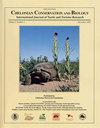Factors Affecting Nesting Ecology of Apalone spinifera in a Northwestern Great Plains River of the United States
IF 0.8
4区 生物学
Q3 ZOOLOGY
引用次数: 14
Abstract
Abstract The nesting ecology of Apalone spinifera in large North American rivers is largely unknown despite the wide distribution of the species in these naturally dynamic ecosystems. We describe the nesting locations, timing, behavior, and habitat of A. spinifera in relation to natural and anthropogenic factors in the Missouri River. Nesting followed annual peak river stage, mostly occurred in the afternoon when air temperatures were 25°–30°C, and did not occur when human activity was nearby. Apalone spinifera nested in June in a year with average discharge (2012), but nested 20 d later in a year with a large flood event (2011). During the average discharge year, 90% of nests were found on islands, but similar proportions of nests were found on island and mainland habitats during the flood year because many islands were inundated. Nests were mostly in mixed-gravel substrates where vegetation cover was sparse or absent. Depredation occurred only after the emergence of hatchlings (∼ 60 d after nesting) and more often on nests on the mainland than on islands. Emergence rates were ∼ 1.5 times higher in the average year than the flood year, and emergence rates were higher in mixed-gravel nests than in pure-sand nests in 2011. In artificial nests, incubation temperatures averaged ∼ 4.3°C higher in mixed-gravel than in sand substrates, and freezing temperatures in winter penetrated to depths greater than the mean egg chamber depth (7.5 cm) for up to 3 wks. Therefore, incubation might be accelerated in mixed-gravel substrates. Accelerated incubation would enhance reproductive success because freezing temperatures preclude hatchlings from overwintering in nests in our study area. Mountain snowmelt-driven hydrology, coupled with the onset of freezing temperatures in autumn, might create a temporal “runoff-freeze squeeze” that limits the successful reproduction of A. spinifera in some years. However, high runoff also scoured vegetation from shorelines where A. spinifera nested in subsequent years. Natural variation in annual discharge might therefore be crucial to conservation of A. spinifera in large rivers.影响美国西北大平原河流中Apalone spinifera筑巢生态的因素
摘要尽管在这些自然动态的生态系统中分布广泛,但在北美大河流中的Apalone spinifera筑巢生态在很大程度上是未知的。本文描述了密苏里河中棘叶蝉的筑巢地点、时间、行为和栖息地与自然和人为因素的关系。巢巢跟随年度河流高峰期,多发生在气温25°-30°C的下午,人类活动附近不发生巢巢。平均流量年份(2012年)的6月筑巢,大洪水年份(2011年)的20 d筑巢。在平均流量年,90%的巢在岛屿上发现,但在洪水年,由于许多岛屿被淹没,在岛屿和大陆栖息地发现的巢比例相似。巢主要分布在植被稀疏或无植被覆盖的混合砾石基质中。捕食只发生在雏鸟出现后(筑巢后约60天),而且在大陆上的巢穴比在岛屿上的巢穴更常见。平均年的出苗率是洪水年的1.5倍,2011年混合砾石巢穴的出苗率高于纯砂巢穴。在人工巢中,混合砾石的孵化温度平均比砂基质的孵化温度高约4.3°C,冬季的冰冻温度可以穿透到大于平均卵室深度(7.5 cm)的深度,持续时间长达3周。因此,在混合砾石基质中,孵育可能会加速。加速孵化会提高繁殖成功率,因为在我们的研究区域,低温会阻止孵化的雏鸟在巢中越冬。山区融雪驱动的水文,再加上秋天开始的冰冻温度,可能会造成暂时的“径流冻结挤压”,在某些年份限制刺草的成功繁殖。然而,在随后的几年里,高径流也冲刷了刺毛虫筑巢的海岸线上的植被。因此,年流量的自然变化可能对大型河流中刺草的保护至关重要。
本文章由计算机程序翻译,如有差异,请以英文原文为准。
求助全文
约1分钟内获得全文
求助全文
来源期刊
CiteScore
1.70
自引率
14.30%
发文量
17
审稿时长
>12 weeks
期刊介绍:
Chelonian Conservation and Biology is a biannual peer-reviewed journal of cosmopolitan and broad-based coverage of all aspects of conservation and biology of all chelonians, including freshwater turtles, marine turtles, and tortoises. Manuscripts may cover any aspects of turtle and tortoise research, with a preference for conservation or biology. Manuscripts dealing with conservation biology, systematic relationships, chelonian diversity, geographic distribution, natural history, ecology, reproduction, morphology and natural variation, population status, husbandry, community conservation initiatives, and human exploitation or conservation management issues are of special interest.

 求助内容:
求助内容: 应助结果提醒方式:
应助结果提醒方式:


